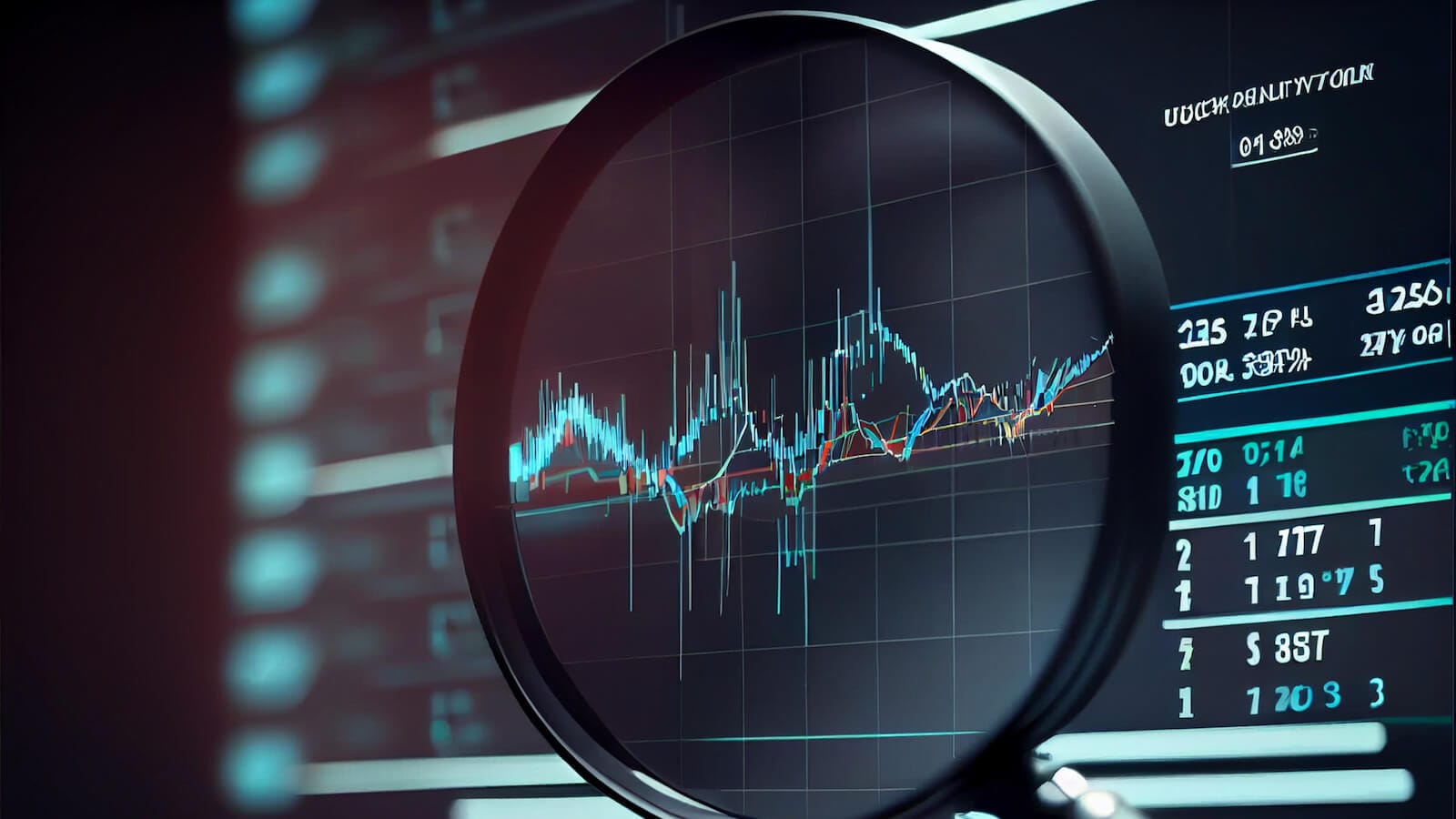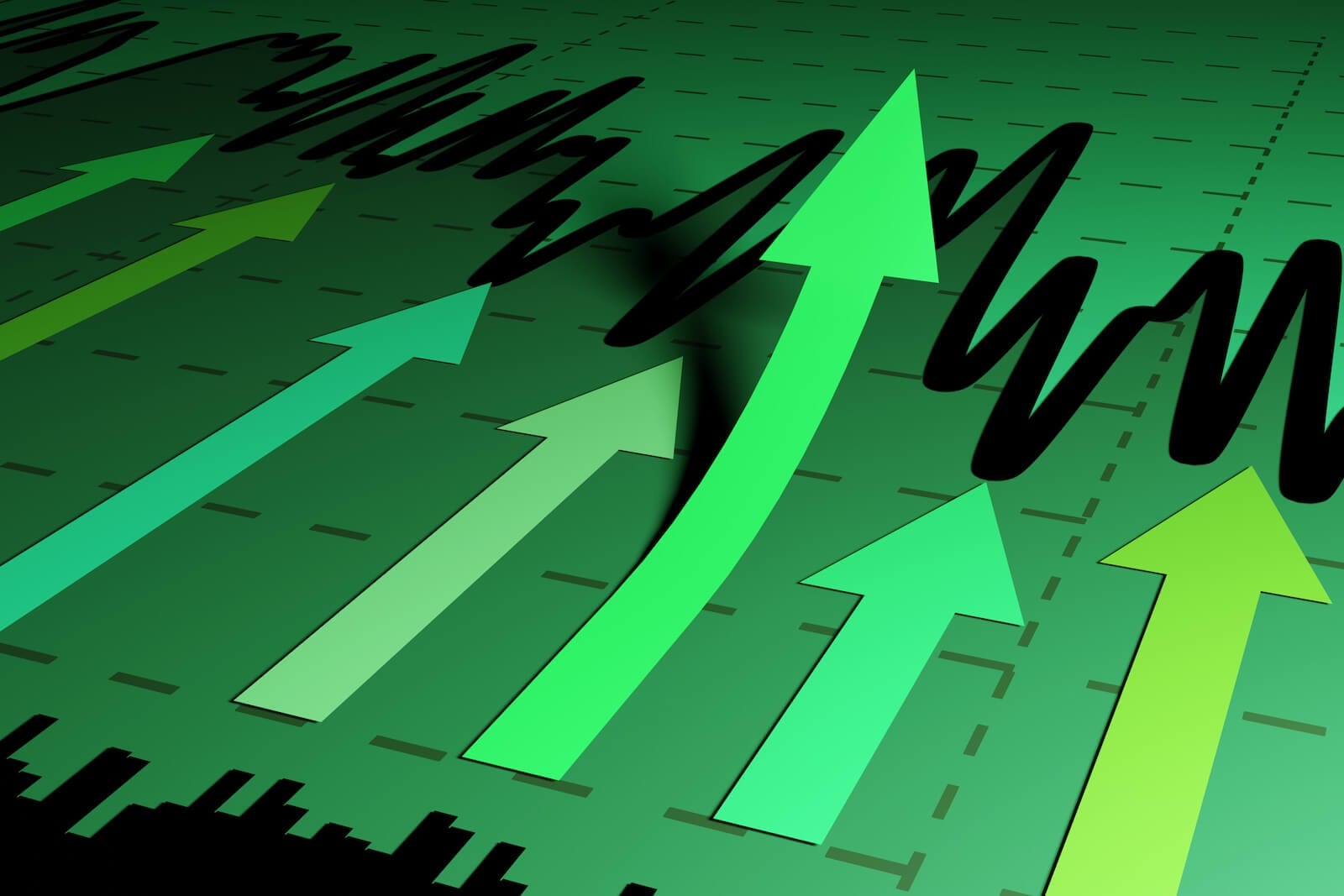Home Prices and Stocks | Focus on Stocks: February 2024
Let's begin this month with a look at ...
Home Prices and Stocks
Most people have the majority of their money in homes and/or stocks. Thus, I thought that this month, I would take a look at what should be happening in the real estate market.
Let's begin with a look at the Year-Over-Year (YOY) change in the median sales price of homes sold with data from the Fed.

The first thing that pops out is that housing prices may (or may not) predict a recession. Recessions are marked with grey vertical bars. Just look, though, at when recessions end... real estate prices have always rallied.
With that thought in mind, I fired up the old computer to see what the most dominant cycles have been. A few scans through, it was clear to me that the 5.4- and 9.2-year cycles are dominant in housing prices.

Here we see the YOY in black vs the cycle projection in red. This accentuates the time real estate prices have rallied... just about every 10 years, homes have cost more.
What a bonanza we have here, a repetitive pattern of when to time our purchases or sales of homes.
Next, we need to see if this is a stable cycle, one we can really hang our hat on.

Here, we have good news! The same pattern continued from 2000 to date, with a projection for the next housing boom to blast off in July 2028. It looks to be a buyers' market until then. Of course, location and property types will vary from this, but overall, expect no runaway bull market in housing. If you are a buyer, bid low. A seller, expect low ball offers and have patience.
This data comes out quarterly at this link.
What Does this Mean, If Anything, for the Stock Market?

In Chart 4, you can see the cycle of housing price overlaid with the Dow Jones. Notice anything? I don't see any strong relationships.
So let's look at the next 20 years.

Marching forward, I am hard-pressed to see any clear-cut association between stocks and the cycle.

Moving forward for the next 20 years, I am still perplexed. I thought there would be some forecasting ability from the data. If there is, I don't see it. Sometimes it leads, other times it lags -- dang! They kind of move together, but not always. What's a chartist to do?

In the event you see a relationship, here is the cycle out to 2030. Looks like best time to buy real-estate will be late 2027. That should be close to the low in housing prices.
Wealth Is Not Health
The most effective "longevity medicine" is the cheapest, but hardest to take; exercise.
We know from the Framingham Study that people who walk a lot live longer and are healthier than ones that don't. The same study shows people who walk fast live longer than slow walkers. People who walked at least 8,000 steps per day -- just one or two days a week -- had a 15 percent lower death rate over the next 10 years, when compared to people who walked less than that (JAMA Netw Open, Mar 29, 2023;6(3): e235184). People who had 3-7 days with 8,000 steps or more had an additional reduction in death rate.
I thought that was due to an increase in lung function. It now seems there is another benefit. Considering heart disease continues to be the leading cause of death in the USA, I learned from what Dr Gabe Mirkin wrote;
"The only way to strengthen any muscle is to contract the muscle against increasingly greater resistance. Your heart is a muscle, so the only way to make your heart stronger is to contract it against greater resistance.
The harder you exercise, the stronger your heart muscle becomes. Going out and running 100 miles a week slowly does not make you very fit because you are not strengthening your heart very much with a little increase in circulation of blood, no matter how long you do it."
I got it! Intense exercise increases both heart and lung function.
The easiest way to do this for walkers, joggers, or runners, is to go at your normal pace for 30 seconds, then pick up the pace for 20 more seconds. Finally, go close to all out for the exercise you are doing for 10 seconds. Then go back to 30 seconds slow, 20 faster, and 10 hard. Work up so you can do this ten times in a row. It's playful. It's fun and great for your heart and lungs. Runners following this program decreased their 5K times in races.
Can Coffee Help You Trade Better?
In a test, 47 people had brain scans before they drank their morning coffee, then another scan 30 minutes after their cup of Joe. 36 other people had the brain scan then the same amount of caffeine as in the coffee, but in warm water. That too was followed by another brain scan. Both groups were more alert ... yet ... the coffee groupshowed increased activity in parts of the hippocampus in the brain that's involved with short term memory, focus, and attention. It appears there is more to coffee than just caffeine (Med J Malaysia, July, 2023;78(4):476-483).
There is a downside to too much coffee. One of my worst trading times was when I had so much coffee, I felt super powerful. So, I got overconfident and into some disastrous trades. Some may be good, but too much is dangerous for traders.
Life is a Balancing Act
We are all aware of how dangerous falls can be for older people. I did not realize it was this dangerous; "The mortality rate for falls increases dramatically with age in both sexes and in all racial and ethnic groups, with falls accounting for 70 percent of accidental deaths in persons 75 years of age and older." (Am Fam Physician. 2000;61(7):2159-2168.)
Most say older people fall because they lose their balance, and surely that is part of it. But there's another part you can start working on now that costs nothing.
When you start to lose your balance, your body immediately corrects it with how you are standing. Weak ankles, as I see it, are the problem. I first realized this when training for the Senior Olympics. Faster sprinters have stronger ankles. Weak ankles mean you can't "catch yourself" as you start to fall. To strengthen your ankles, walk barefoot. Walk on your toes, then walk on your heels (careful) to build up these muscles and protect you from falling. There are lots of YouTube videos on this as well. Strong people fall less. Muscle loss and ankle strength will keep you upright.
Nailing Down the Business Cycle
It looks like nothing nails down "how business is" and its cycle than the FED's measure of new orders for durable goods.
New orders only come in when:
- People have money; and
- They are willing to spend it.
No complex economic stuff going on here.
Just as simple is the fact that business makes money with these new orders, which means the potential for corporate profits go up. What does that mean to us? Duh! Higher stock prices.

Here's a link to the data going back to 1993, available monthly.
Let's begin by looking at how the data looks vs. stock prices.

Wow! Looks like a pretty close fit to the Dow (shown in blue). Close enough that my next step is to find the cycle of this data. The point is that if we can find the cycle, we can predict when the economy should get better. When it does, stocks should have major rallies. That's my thinking, so let's see what we can learn.

Thanks to Timing Solution software, we have many ways of probing to find the most reliable cycle for this data. My work, hunch/guess/testing, shows a strong 45-month cycle. You can see that in the above chart; it is the red line. Next, we will take a look at what impact that cycle has on stocks.

Well, here it is ... Chart 11. The red line is the cycle from the prior chart. I dropped off the black line of New Orders, replacing it with the Dow Jones in blue. And this is an eye opener! Lows in the red line are indicative of times when stocks rally.
Why is this important? Usually, we just run cycles on stock prices. Not with this; here, we have exogenous data to help forecast stock prices.
One of the great lessons I learned in Logic 101 at the University of Oregon was that you cannot or should not try to predict A with A. That's the classical problem of most technical analysis... predicting price with price.

Seeing The Future Today... In Chart 12, I show the cycle projection, a projection for stock prices based on new orders for business, out to 2026. Now take a look at this and the prior chart to see what the Dow has done when the cycle is in a powerful upswing, at it is now.
The recession-mongers are about to be embarrassed again.
TDOM Trades for February
We are now looking at very short-term opportunities for traders, not investors. What follows are the results of buying/selling on a specific trading day, not calendar days, for February.
Our exit is a dollar stop, or the first profitable opening after being in the trade for 2 trading days. The data here is for one contract of the futures market. If you are not a commodity trader, look for the same short-term moves in the ETFs.
Personally, I do not take all trades, nor always on the opening. I try to use some common sense and look at what the market is doing before I enter. These tables are a great assist in telling me when to focus and when to be alert. This test is run on the ES futures contract.
Stocks

The high probability for a rally in stocks this month comes at TDOM 8 and 9, both sporting +80% accuracy in the last 25 years. Let's take a visual look with my True Seasonal indicator, available in StockCharts.com. For an ETF use QQQ or SPY. Note the far-right column shows the stop loss used was $2,600 on the futures contract.

Typically, stocks have been sideways as February begins, then pop up for a few days before falling back down. If you are using calendar days, the move should begin on the 9th or 10th.
Bonds
The US 30-Year Treasury bonds are the most actively traded futures contract. The ETF to trade is TLT. Here is how bonds have usually traded in February.


One glance at the chart tells us to temper buying in this month. The only sweet spot comes at month-end. TDOM 15 has been the best. A $1,625 stop was employed in this test for both buys and sells.

Given what we have seen, it makes sense to look for sells at this time. Testing shows our best trades have come at the first of the month, with TDOM 1 being the best.
Gold

Here we have another clear picture of how Gold has usually begun to rally shortly after the month begins.

The optimal trade has been to buy on the ninth trading session, then hold for 2 days. The stop loss used was $1,700. More money, but less accuracy, comes from an 8-day hold before looking to exit.
Market Timing for February
"The Dow is a stock market average, but it's also a market of stocks." Lots of new traders get confused by that old adage. What it means is that, on average stocks move together, yet, on average, your stock may not. How do we use this to our advantage as traders/investors?
The answer is that we use projected turning points in the averages to identify times individual issues should rise and fall. We also need to pay attention to our stocks, as they may be on a different dance floor. I will start with overall market timing, then move to individual stock timing.
Stock Market Timing
Here, we see the seasonal pattern for the venerable Standard and Poor's 500-stock average. This pattern permeates through all averages, such as the NDQ, Small Caps, Large Caps, etc., except for the Dow Utility Average. What we see is that February usually starts with a rally, then later in the month takes a dive.

More importantly, the late January low is higher than the December low, as it appears this year will be. That means that 2024, so far, is in phase and congruent with all past years.
Of more importance is that the peak seen in February is usually higher than the seasonal high seen in January. If, come late February, the Dow is below the January high, it means price is weaker than what is typical, so the seasonal downdraft has a much, much higher probability of being correct. Short-term traders will want to look for this divergence to confirm short sell positions.
Dance with Who You Brought to the Dance
Cycles have not been doing a stellar job here, as they say down, yet price has rallied. How does this get resolved? Does it matter?
This is what I have come to believe and have learned to do; you dance with who you brought to the dance. We have had a few really good turns on the dance floor with cycle forecasts. I will keep dancing with them. Look, no technique is going to always be right in the game; never, ever. I want to use my best tools and stay consistent. That puts the odds in my favor, which is all I can ask for.
Let's see what cycles are telling us now.

You have probably already figured it out; the red line is the short-term cycle forecast. Green is a longer term. Cycles are what they are -- an analysis of the time between market tops and bottoms. The red line is the expected path price will take with shorter term moves. The green line has been, and is, positive for all of 2024. It looks to me like a real good buy point is coming up in late March.
Two Confirmation Tools
My two favorite confirmation tools for an internal look at overall market strength are my Accumulation Index and the Advance Decline line.

Here we see the power of the Accumulation Index where we look for divergence between price and accumulation. Ideally, on a new market high, we should also see a new high in accumulation.
Last fall provides a good example of where the new rally high was not confirmed and, as you can see, what followed. At the November lows, we had just the opposite formation. As it stands right now, we again see the bearish divergence pattern.

The same bearish divergence is in Chart 18. You are looking at price vs the Advance Decline Line. This line, or index, is the cumulative net difference of stocks that closed higher or lower for the day. Some refer to this as market breadth. What we can say for sure at this time is that majority of stocks have not made a new high in the rally the way the S&P 500 has.
In other words, this has been a selective rally. Most often (but not always, as "always" is a word one needs to be used with caution when talking about stocks) the market averages have tumbled after this bearish pattern has appeared.
The bottom line here is we are at a time to expect cyclical weakness, and now see a lack of accumulation and market breadth to confirm recent strength. I remain cautious and patient.
Bitcoin
As I see it, we have just completed a major top in the market. There are many reasons why, including the recent offering of ETFs for all sorts of Coins. That removed a lot of money from buyers' wallets that cannot be employed anymore. And then there is this chart.

This is such an intriguing indicator, as it works on all markets, stocks, or futures. When it gets above 60, the current move -- up or down -- is about over. It's our "end of the trend" tool. It is telling us we are at the end of the recent up trend in GBTC, the largest of the Bitcoin plays. A short-term rally is in the wings, and should be sold when we get overbought.
Update on Individual Stocks
Troubles for Tesla?
I've been told Jim Cramer has dropped Tesla from his "Magnificent Seven" group of stocks. He will add Eli Lilly. So let's look at these two stocks.

Looks like Jim is right on this one as the longer-term cycle, blue in Chart 21, is down for rest of this year. We should expect rallies in early April and mid-August. Late June looks to be the time to put on short positions.

Here I think Cramer is wrong based on my meagre study of cycles. The longer-term cycle suggests lower prices and selling pressures for most of the year for Eli Lilly. Turning points are just about now, early April, and late September. I would not be a long-term investor here, at least not yet.
A Message from the FANG Gang

The fabulous five stocks that make up the widely touted "FANG" index are Meta (Facebook), Apple, Amazon, Netflix, and Google. They have been a good leading indicator of what the less volatile stocks will do. Chart 22 shows the ETF FNGU, a good representation of this group along with the most dominant cycle. The forecast is pretty clear; the group is not primed for much more upside action. Come May, we will want to take a look, but right now the suggestion is for selling pressures.
That tells me the rest of the market -- yes, the tail wags the dog here -- will be headed lower, or at least sideways.
My 2024 Forecast vs Charts in the Monthly Letter
As mentioned in our January live session, if you purchased my 2024 forecast report you will have noticed our 5 stocks of the year for 2024 charts are a little different in the letter than the report. Why? My Forecast 2024 report seeks to find the longer-term cycles that will last for the full year. In this letter, I want to show the most dominant cycles operating "right here, right now."
(Please note that these charts use daily data, not weekly as in the forecast report.)
I will show updated cycles for those 5 stocks; most every month in this letter. Let's wrap up this month's letter with a look at those stocks.





As I see it...
This is still not a time to buy stocks. Be patient, and make certain you attend our Family Gathering mid-month online meeting for an update.
Until then...
Good Luck and Good Trading,
Larry Williams
If you have questions for Larry that you'd like addressed in future postings, please email familygathering@stockcharts.com.










